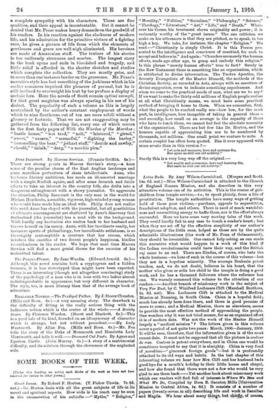Lotus Buds. By Amy Wilson-Carmichael. (Morgan and Scott. 14s. 6d.
net.)—Miss Wilson-Carmichael is attached to the Church of England Zenana Mission, and she describes in this very attractive volume one of its activities. This is the rescue of girl- children from temple service,—i.e., to speak plainly, from a life of prostitution. The temple authorities have many ways of getting hold of these poor victims,—purchase, appeals to superstition, fraudulent adoption, and others. There is need of much watchful- ness and unremitting energy to baffie them, nor is the effort always successful. Here we have some very moving tales of this work. They could hardly fail in any case to touch a reader's heart ; but when they are set off by the effective simplicity of our author's descriptions of the little ones, helped as these are by the quite admirable illustrations (the work of Mr. Penn of Ootacamund), they should be irresistible. One cannot help asking as one reads this narrative what would happen to a work of this kind if the Indian revolutionaries could have their way, and the British raj came to an end. There are Hindus, of course, who hate the whole business—we hear of such in the course of this volume—but they are in a hopeless minority. The average Brahmin priest teaches, and, we do not doubt, believes in his heart, that the mother who gives or sells her child to the temple is doing a good work, and he has a thousand followers where the reformer has one. We warmly commend this volume to the attention of our readers.—Another branch of missionary work is the subject of Very Far East, by C. Winifred Lechmere Clift (Marshall Brothers, 3s. 6d. net). Mrs. Lechmere Clift is attached to the Medical Mission at Nanning, in South China. China is a hopeful field ; much has already been done there, and there is good promise of more to come ; and a Medical Mission, there as elsewhere, seems to provide the most effective method of approaching the people. One wonders why it was not tried sooner, for as an organised effort it is of modern date. Was not the work of the Master Himself largely a "medical mission " ? The letters given in this volume cover a period of not quite two years: March, 1906—January, 1908. It will be seen, therefore, that the information given is of the most recent date. It must not be supposed that all the picture is couleur de rose. Custom is potent everywhere, and in China one would be sometimes tempted to say that it is almighty. China is very fond of ,novelties—" gimcrack foreign goods "—but it is profoundly attached to its old ways and habits. In the last chapter of this interesting volume we hear how Mrs. Clift and her husband bade good-bye for a month's holiday to their little house and chapel, and how she found that there were not a few who would be very glad to see them back.—Yet another book about missionary work which our readers will find full of interest is Where We hive and What We Do, Compiled by Dora E. Gunton. Mills (Uniiersities Mission to Central. Africa, ls. 6d.) It consists of .a number of papers (twenty-seven in all) describing life .and work in Zanzibar and Magila. We hear about many things, but_ctigy, of course,
about the life of the women. Vacuity and indolence in the upper class, unspeakable degradation in the lower, for sla.vary is still the common oanditien, are deplorably prevalent.















































 Previous page
Previous page